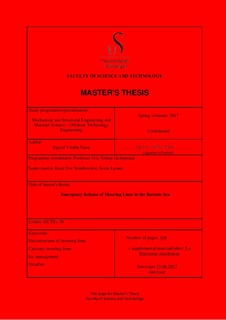| dc.contributor.advisor | Gudmestad, Ove Tobias | |
| dc.contributor.advisor | Steinhovden, Knut Ove | |
| dc.contributor.advisor | Larsen, Svein | |
| dc.contributor.author | Næss, Sigurd Vestbø | |
| dc.date.accessioned | 2017-10-19T08:11:09Z | |
| dc.date.available | 2017-10-19T08:11:09Z | |
| dc.date.issued | 2017-06 | |
| dc.identifier.uri | http://hdl.handle.net/11250/2460957 | |
| dc.description | Master's thesis in Offshore structural engineering | nb_NO |
| dc.description.abstract | With increasing offshore activities in the Barents Sea, the need for risk reducing measures will increase as well. In the Arctic, the weather can change rapidly and is characterized by being difficult to forecast. As a final defense, a platform should be able to safely shut-down current operation, disconnect from its mooring lines and evacuate the site. The disconnection process will depend on the type of operation, whether exploration or production.
To analyze a disconnecting mooring line, the software program Orcaflex was used to analyze the disconnection process on a semi-submersible drilling rig, in time domain. The results are discussed with respect to safety and the possibility of reconnecting the mooring line. Discussion about relevant parameters for disconnection is also presented.
The upper parts of the mooring wire will in cases where the wire is taut, hit the pontoons of the rig. The maximum impact force calculated was approximately 200kN, which is assumed to be negligible with respect to damage to the rig itself, making damages to the wire a primary concern. Using a chain segment of 2 meter between the mooring wire and release tool will dampen the recoil to a more acceptable level, although there will be some movements of the release tool. Using more than 2-meter chain segments will induce shock-loads in the wire. Bending stress due to curling of the wire rope will not exceed the yield stress in individual wires.
Once the leeward mooring lines are disconnected, the rig should be manually move up against the wind or the wire rope should be paid out to approximately 300 meters to lessen the tension. At this release point, no significant curling will form on the wire rope, there will be no hull contact and no line clash provided 2-meter chain segment is used. G-forces must be accounted for in the design of the release tool, and the tool should passively protect weak components such as electronic components. | nb_NO |
| dc.language.iso | eng | nb_NO |
| dc.publisher | University of Stavanger, Norway | nb_NO |
| dc.relation.ispartofseries | Masteroppgave/UIS-TN-IKM/2017; | |
| dc.rights | Attribution-NonCommercial-NoDerivatives 4.0 Internasjonal | * |
| dc.rights.uri | http://creativecommons.org/licenses/by-nc-nd/4.0/deed.no | * |
| dc.subject | OrcaFlex | nb_NO |
| dc.subject | offshore structural engineering | nb_NO |
| dc.subject | disconnection of mooring lines | nb_NO |
| dc.subject | catenary mooring lines | nb_NO |
| dc.subject | ice management | nb_NO |
| dc.subject | offshore technology | nb_NO |
| dc.subject | offshore teknologi | nb_NO |
| dc.title | Emergency Release of Mooring Lines in the Barents Sea | nb_NO |
| dc.type | Master thesis | nb_NO |
| dc.subject.nsi | VDP::Technology: 500::Building technology: 530::Construction technology: 533 | nb_NO |

